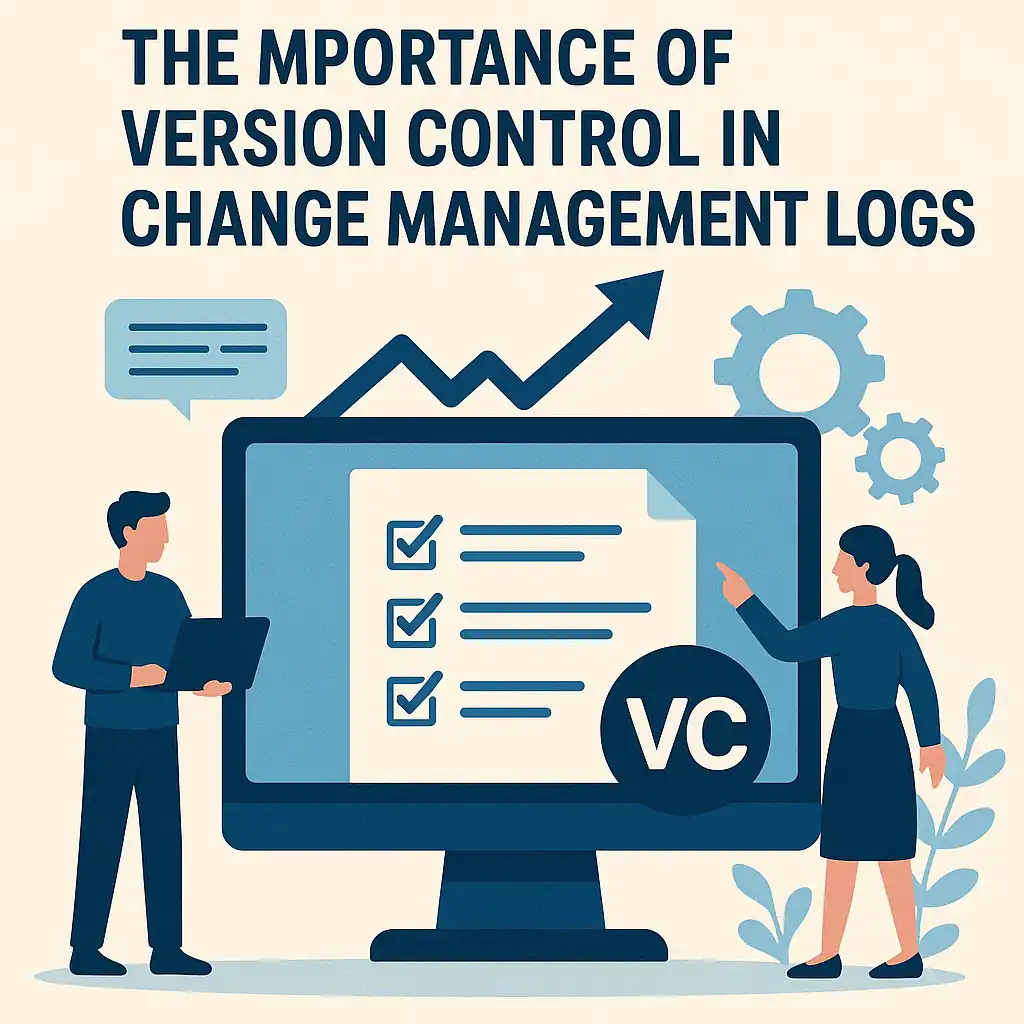Introduction to Change Management Logs
Change management logs serve as essential tools for tracking and documenting changes throughout the lifecycle of a project. These logs are critical for ensuring that all modifications—whether they pertain to project scope, schedule, or budget—are systematically recorded and managed. By maintaining a comprehensive change management log, project managers can effectively monitor the evolution of a project, ensuring that all stakeholders are informed and that the project remains aligned with its objectives.
Defining Change Management Logs
Change management logs are structured records that capture all requests for changes, including their status, impact, and the individuals responsible for implementing them. They typically include elements such as:
- Date of Request: When the change was proposed.
- Owner: The individual responsible for the change.
- Impact Summary: An assessment of how the change will affect the project.
- Status: Current state of the change request (e.g., approved, pending, rejected).
- Priority: The urgency of the change request.
These logs not only facilitate communication among team members but also provide a historical account of decisions made throughout the project, which can be invaluable for future reference and audits.
Significance of Maintaining Accurate Logs
Accurate change management logs are vital for project success for several reasons:
- Transparency: They promote transparency by documenting who made changes and why, which helps in building trust among team members and stakeholders.
- Accountability: By clearly assigning ownership of change requests, logs ensure that individuals are accountable for their contributions to the project.
- Risk Management: Maintaining detailed records allows project managers to assess the potential risks associated with changes, enabling them to make informed decisions.
- Performance Tracking: Logs provide insights into how changes impact project timelines and deliverables, allowing for better performance tracking and adjustments as needed.
Version Control as a Tool for Managing Changes
Incorporating version control into change management logs enhances their effectiveness significantly. Version control systems track every change made to project documents and files, allowing project managers to revert to previous versions if necessary. This capability is particularly beneficial in software development, where code changes can have far-reaching implications. By utilizing version control, teams can:
- Maintain Historical Context: Version control keeps a history of changes, making it easier to understand the evolution of a project and the rationale behind specific decisions.
- Facilitate Collaboration: Multiple team members can work on different aspects of a project simultaneously without the risk of overwriting each other’s contributions, as version control systems manage these changes seamlessly.
- Enhance Recovery Options: In the event of an error or a decision that needs to be reversed, version control allows teams to revert to a stable version of the project, minimizing disruptions.
Understanding Version Control
Version control is a critical component in project management, particularly in the realm of software development. It refers to a system that records changes to files over time, allowing users to track revisions, revert to previous states, and collaborate more effectively. This systematic approach to managing changes ensures that the latest version of a document or code is always accessible, which is essential for maintaining the integrity and quality of a project [8][12].
Importance of Version Control in Software Development
The significance of version control in software development cannot be overstated. It serves several key purposes:
- Traceability: Version control maintains records of document versions, enabling project teams to trace the evolution of design and compliance documents. This traceability is crucial for understanding the context of changes and ensuring accountability [2][14].
- Error Prevention: By protecting source code from both catastrophic failures and the casual degradation caused by human error, version control systems help safeguard the integrity of the project. This is particularly important in collaborative environments where multiple developers may be working on the same codebase [5][12].
- Collaboration: Version control facilitates collaboration among team members by allowing them to work on different parts of a project simultaneously without overwriting each other’s changes. This is achieved through features like branching and merging, which are fundamental to effective teamwork [10][12].
Centralized vs. Decentralized Version Control Systems
Version control systems can be categorized into two main types: centralized and decentralized.
- Centralized Version Control Systems (CVCS): In a CVCS, there is a single central repository where all files are stored. Users check out files from this central location, make changes, and then check them back in. This model simplifies management but can create bottlenecks, as all changes must go through the central server. Examples include Subversion (SVN) and Perforce [10].
- Decentralized Version Control Systems (DVCS): In contrast, DVCS allows each user to have a complete copy of the repository on their local machine. This means that users can work offline and commit changes to their local repository before pushing them to a central server. This model enhances flexibility and reduces the risk of server-related issues. Popular examples include Git and Mercurial [10].
Key Features of Version Control Systems
Version control systems come equipped with several key features that enhance their functionality:
- Branching: This feature allows developers to create separate lines of development within the same project. Branching is useful for experimenting with new features or fixing bugs without affecting the main codebase. Once the changes are validated, they can be merged back into the main branch [10][12].
- Merging: Merging is the process of integrating changes from different branches. It ensures that all contributions are combined into a cohesive whole, which is essential for maintaining project continuity and coherence [10][12].
- History Tracking: Version control systems maintain a detailed history of changes, including who made each change and when. This audit trail is invaluable for identifying issues, understanding project evolution, and reverting to previous versions if necessary [13][14].
The Relationship Between Version Control and Change Management Logs
The integration of version control systems (VCS) with change management logs is crucial for maintaining order and clarity. This synergy not only enhances the effectiveness of change management but also ensures that teams can navigate the complexities of collaborative projects with ease. Here’s how version control contributes to effective change management logging:
Historical Context for Changes Logged
Version control systems provide a comprehensive historical record of all changes made to a project. Each modification is meticulously tracked, detailing who made the change, when it occurred, and the rationale behind it. This historical context is invaluable for project managers and developers as it allows them to:
- Trace the evolution of a project: Understanding the sequence of changes helps teams analyze the development process and make informed decisions moving forward [8].
- Facilitate audits and reviews: With a clear log of changes, teams can easily conduct audits to ensure compliance with project standards and regulations [3].
- Learn from past decisions: By reviewing previous changes, teams can identify what worked well and what didn’t, fostering a culture of continuous improvement [15].
Preventing Conflicts and Ensuring Consistency
One of the primary challenges in collaborative projects is the potential for conflicts when multiple team members work on the same components. Version control systems play a pivotal role in mitigating these issues by:
- Managing concurrent changes: VCS allows developers to work on different features simultaneously without overwriting each other’s work. This is particularly important in large teams where multiple changes may occur at once [10].
- Maintaining a consistent codebase: By tracking every change, version control ensures that all team members are working from the same version of the code, reducing discrepancies and enhancing overall project coherence [12].
- Facilitating conflict resolution: When conflicts do arise, version control systems provide tools to compare changes and resolve discrepancies efficiently, ensuring that the final product reflects the best contributions from all team members [11].
Streamlining the Review and Approval Process
The review and approval process is a critical aspect of change management, and version control systems can significantly streamline this workflow by:
- Providing a clear change history: Reviewers can easily access the history of changes, making it simpler to evaluate the impact of proposed modifications [9].
- Enabling collaborative feedback: With version control, team members can comment on specific changes, facilitating discussions and ensuring that all perspectives are considered before final approval [14].
- Automating notifications and updates: Many version control systems can automatically notify team members of changes, keeping everyone informed and engaged throughout the review process [6].
Benefits of Integrating Version Control with Change Management Logs
The integration of version control with change management logs is crucial for maintaining an organized and efficient workflow. Here are some key benefits that highlight the importance of this integration:
- Improved Collaboration Among Team Members: By utilizing version control systems, teams can create shared change logs that are accessible to all members. This transparency fosters better communication and collaboration, as everyone can see the history of changes made, who made them, and the rationale behind those changes. This shared understanding helps to align team efforts and reduces the chances of conflicts arising from overlapping work or misunderstandings about project status [1][10].
- Facilitated Rollback of Changes: One of the significant advantages of version control is its ability to track changes over time. If a particular change leads to unforeseen issues or does not yield the expected results, version control allows teams to easily revert to a previous state of the project. This capability is essential for maintaining project stability and minimizing disruptions, as it provides a safety net for experimentation and innovation without the fear of permanent setbacks [6][8].
- Enhanced Traceability and Accountability: Version control systems inherently provide a detailed history of changes, which enhances traceability. Each modification is logged with information about who made the change and when it occurred. This level of detail not only aids in understanding the evolution of the project but also establishes accountability among team members. When issues arise, project managers can quickly identify the source of changes and address any concerns, ensuring that all team members are responsible for their contributions [1][14].
Best Practices for Implementing Version Control in Change Management
The integration of version control with change management logs is crucial for maintaining project integrity and ensuring seamless collaboration. Version control systems (VCS) not only track changes to code but also play a significant role in documenting modifications made during the project lifecycle. This section will explore best practices for implementing version control in change management logs, providing actionable strategies for software developers and project managers.
Establish Clear Guidelines for Logging Changes
It is essential to create comprehensive guidelines that outline how changes should be logged within the version control system. This includes defining:
- Naming Conventions: Use consistent naming conventions for commits to make it easier to identify the purpose of each change.
- Version Numbering System: Implement a systematic version numbering approach to track the evolution of the project effectively. This helps in understanding the progression and rollback if necessary [3][12].
- Descriptive Commit Messages: Encourage team members to write clear and descriptive commit messages that start with a verb in the present tense. This practice enhances clarity and provides context for future reference [8].
Train Team Members on Proper Use of Version Control Tools
Training is vital to ensure that all team members are proficient in using version control tools. This can include:
- Workshops and Tutorials: Conduct regular training sessions to familiarize the team with the version control system and its features.
- Documentation: Provide clear documentation on the version control process, including how to log changes, resolve conflicts, and manage branches effectively [2][10].
- Mentorship: Pair less experienced team members with seasoned developers to foster knowledge sharing and practical learning.
Regularly Review and Audit Change Management Logs
To maintain the integrity of change management logs, it is important to conduct regular reviews and audits. This involves:
- Scheduled Audits: Implement a schedule for auditing change logs to ensure compliance with established guidelines and to identify any discrepancies [1][14].
- Feedback Mechanism: Create a feedback loop where team members can report issues or suggest improvements to the logging process.
- Continuous Improvement: Use insights gained from audits to refine logging practices and enhance the overall change management process [11][15].
By following these best practices, software developers and project managers can effectively integrate version control with change management logs, leading to improved project outcomes and enhanced collaboration. The systematic tracking of changes not only aids in maintaining project documentation but also ensures that all team members are aligned and informed throughout the project lifecycle.
Case Studies: Successful Implementation of Version Control in Change Management
The integration of version control systems with change management logs has proven to be a game-changer. This section explores real-world examples that illustrate the benefits of this integration, focusing on the challenges faced, the solutions provided by version control, and the measurable outcomes achieved.
Case Study 1: IBM’s Transformation
IBM’s shift towards a services and software-oriented model serves as a prime example of effective change management through version control. The company faced significant challenges in managing changes across its vast software products. By implementing a robust version control system, IBM was able to:
- Enhance Collaboration: Multiple teams could work on different aspects of the software simultaneously without conflicts, thanks to the tracking capabilities of version control systems. This led to a more cohesive development process.
- Reduce Errors: The ability to revert to previous versions of code minimized the risk of introducing bugs during updates. This was particularly crucial in maintaining the integrity of their multi-million line software products [13].
- Measurable Outcomes: As a result of these changes, IBM reported increased profitability and efficiency in their development processes, showcasing the direct impact of version control on their change management efforts [13].
Case Study 2: Adobe’s HR Transformation
Adobe’s transformation of its HR functions illustrates another successful integration of version control with change management logs. The company faced challenges in aligning its HR processes with strategic business goals. By adopting version control practices, Adobe was able to:
- Streamline Processes: Version control allowed for better tracking of changes in HR policies and procedures, ensuring that all stakeholders were on the same page.
- Facilitate Communication: The transparency provided by version control systems improved communication among teams, which was essential during the transition period.
- Improved Efficiency: Adobe reported a significant reduction in the time taken to implement changes, leading to a more agile HR function that could respond quickly to business needs [12].
Challenges and Solutions
Both case studies highlight common challenges faced during the integration of version control with change management logs:
- Resistance to Change: Teams often resist adopting new systems. To overcome this, both IBM and Adobe invested in training and change management strategies that emphasized the benefits of version control.
- Initial Setup Complexity: Setting up a version control system can be complex. However, both companies approached this by starting with pilot projects that allowed them to refine their processes before full-scale implementation.
Measurable Outcomes
The integration of version control with change management logs has led to several measurable outcomes across these case studies:
- Increased Efficiency: Both IBM and Adobe reported significant improvements in their development cycles, with faster turnaround times for changes and updates.
- Reduced Errors: The ability to track changes meticulously and revert to previous versions resulted in fewer errors and higher quality outputs.
- Enhanced Collaboration: Teams experienced improved collaboration, leading to more innovative solutions and a stronger alignment with organizational goals.
Conclusion
In project management, particularly within software development, maintaining a comprehensive change management log is crucial. These logs serve as a vital record of all changes made throughout the project lifecycle, ensuring transparency and accountability. They allow project managers and teams to track modifications, understand the rationale behind changes, and assess their impact on project objectives. This practice not only aids in communication among team members but also provides a historical reference that can be invaluable for future projects and audits [15].
The integration of version control into change management logs significantly enhances these logging practices. Version control systems track the evolution of changes, allowing teams to revert to previous states if necessary and to understand the context of each modification. This systematic approach minimizes errors and miscommunication, fostering a more organized and efficient workflow. By utilizing version control, project teams can ensure that their change management logs are not only accurate but also easily accessible and understandable [8][4].
To achieve better project outcomes, it is essential for software developers and project managers to adopt best practices in managing change. This includes regularly updating change management logs, utilizing version control tools effectively, and fostering a culture of open communication regarding changes. By prioritizing these practices, teams can navigate the complexities of project management with greater confidence and success, ultimately leading to more successful project deliveries and satisfied stakeholders.
Find out more about Shaun Stoltz https://www.shaunstoltz.com/about/.
This post was written by an AI and reviewed/edited by a human.



